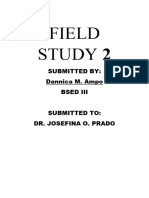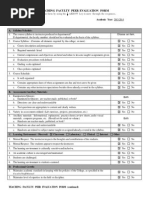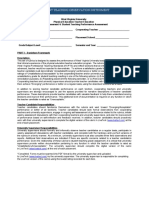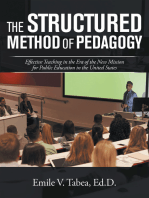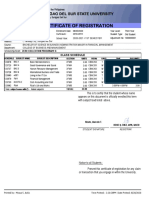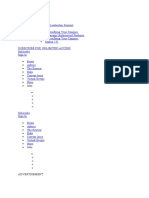0 ratings0% found this document useful (0 votes)
0 viewsQuestionnaire
Questionnaire
Uploaded by
werkamuluneh2721The document is a questionnaire designed to assess the effectiveness of inclusiveness courses at Hawassa University, focusing on undergraduate students' demographics and their perceptions of the course content, teaching methods, teacher competency, assessment practices, and student engagement. It includes sections for demographic information and a series of statements for students to rate their agreement on a scale from strongly disagree to strongly agree. The aim is to gather feedback to improve the inclusiveness course offerings.
Copyright:
© All Rights Reserved
Available Formats
Download as DOCX, PDF, TXT or read online from Scribd
Questionnaire
Questionnaire
Uploaded by
werkamuluneh27210 ratings0% found this document useful (0 votes)
0 views2 pagesThe document is a questionnaire designed to assess the effectiveness of inclusiveness courses at Hawassa University, focusing on undergraduate students' demographics and their perceptions of the course content, teaching methods, teacher competency, assessment practices, and student engagement. It includes sections for demographic information and a series of statements for students to rate their agreement on a scale from strongly disagree to strongly agree. The aim is to gather feedback to improve the inclusiveness course offerings.
Original Description:
Question
Copyright
© © All Rights Reserved
Available Formats
DOCX, PDF, TXT or read online from Scribd
Share this document
Did you find this document useful?
Is this content inappropriate?
The document is a questionnaire designed to assess the effectiveness of inclusiveness courses at Hawassa University, focusing on undergraduate students' demographics and their perceptions of the course content, teaching methods, teacher competency, assessment practices, and student engagement. It includes sections for demographic information and a series of statements for students to rate their agreement on a scale from strongly disagree to strongly agree. The aim is to gather feedback to improve the inclusiveness course offerings.
Copyright:
© All Rights Reserved
Available Formats
Download as DOCX, PDF, TXT or read online from Scribd
Download as docx, pdf, or txt
0 ratings0% found this document useful (0 votes)
0 views2 pagesQuestionnaire
Questionnaire
Uploaded by
werkamuluneh2721The document is a questionnaire designed to assess the effectiveness of inclusiveness courses at Hawassa University, focusing on undergraduate students' demographics and their perceptions of the course content, teaching methods, teacher competency, assessment practices, and student engagement. It includes sections for demographic information and a series of statements for students to rate their agreement on a scale from strongly disagree to strongly agree. The aim is to gather feedback to improve the inclusiveness course offerings.
Copyright:
© All Rights Reserved
Available Formats
Download as DOCX, PDF, TXT or read online from Scribd
Download as docx, pdf, or txt
You are on page 1of 2
Questionnaire on: Determining the Effectiveness of Practices in Offering Inclusiveness Course: A Study of
Undergraduate Students Hawassa University
SECTION A : DEMOGRAPHIC PROFILE: Please kindly respond to the questions below as it
relates to you. You may tick (√) as appropriate
1. GENDER: Male ( ) Female ( )
2. Academic year: 1st year ( ) 2nd year ( ) 3rd year ( ) 4th year ( )
3. COLLEGE: College of Engineering ( ) College of Education ( ) College of Social Science ( ) College of
Agriculture ( )
4. PROGRAMME: Regular () Weekend () Night ()
SECTION B: The following table presents five issues firstly the nature of inclusiveness course given to
you, secondly teaching method your teacher used while teaching, at third teacher competency/knowledge
level, fourthly practices in assessment and lastly about students participation character. Please tick (√) as
deemed appropriate to you any of the options provided below:
Strongly disagree (1), Disagree (2), neutral (3), agree (4) and strongly agree (5)
Items 1 2 3. 4 5
1. About the inclusiveness course
The presented course content was clear, attractive and relevant to course outlines
This course can change learner’s less knowledge and attitude about people with disabilities
The objectives of this course can be easily mastered
The course can enables students to love people with disabilities and vulnerabilities
2. The Teaching Approach
The teacher provided course outlines before the class began
Lecture materials are related to the course objectives
The teacher used participatory approach and many examples during lecturing
We were frequently given a chance to ask and respond to questions
3. Teacher’s knowledge
The teacher know very well about the course
The presented lecture notes are very details and clear to understand
I have got more knowledge about People with disabilities very well
Because of teacher’s behavior, we liked the course too
4. The Assessment
The teachers use used variety of assessment related to course objectives
The teacher provided us feedback after assessments
The given assessments were well designed and educative
The instruction, words, and hierarchies in assessment contents were clear and has no
complexity
5. Student’s Engagement
Almost all students attend the class
All assignments and activities were actively done by students
I was provided with many opportunities to interact with my instructor
I recommend this lecturer for other groups
Thank you so much for your response
You might also like
- Ateneo Appeal Letter 2Document2 pagesAteneo Appeal Letter 2Jericho Ventanilla100% (3)
- DLL Format For Teaching DemonstrationDocument4 pagesDLL Format For Teaching DemonstrationENjay Javier100% (1)
- MATH 110 - DR Wong PDFDocument10 pagesMATH 110 - DR Wong PDFSubra SuppiahNo ratings yet
- YEAR 3 Ache SRJDocument18 pagesYEAR 3 Ache SRJadonufranciscadarko1234No ratings yet
- Student Satisfaction QuestionnaireDocument1 pageStudent Satisfaction QuestionnaireAmber Ebaya100% (1)
- GMT-GUIDEDocument5 pagesGMT-GUIDEawokegoshiNo ratings yet
- Test 2023Document11 pagesTest 2023all.face98No ratings yet
- FS2BOOKDocument63 pagesFS2BOOKDannica AmpoNo ratings yet
- A Syllabus Didactics of GrammarDocument4 pagesA Syllabus Didactics of GrammarAbby FernándezNo ratings yet
- The Important Role of Lesson Plan On Educational Achievement of Iranian EFL Teachers' AttitudesDocument7 pagesThe Important Role of Lesson Plan On Educational Achievement of Iranian EFL Teachers' AttitudesItalo Aarón Milla LozanoNo ratings yet
- Annisa Latifa Article PPL 2023Document8 pagesAnnisa Latifa Article PPL 2023annisalatifa152No ratings yet
- Practical Research Sample Format 2Document100 pagesPractical Research Sample Format 2jhon bonaventeNo ratings yet
- CP Esem 5133 May 2013 KK KeningauDocument4 pagesCP Esem 5133 May 2013 KK KeningauleaNo ratings yet
- Key Assessment 4 Danielson Framework 2022 Official Version 2Document25 pagesKey Assessment 4 Danielson Framework 2022 Official Version 2api-367094506No ratings yet
- EXEMPTION Report - 2020Document5 pagesEXEMPTION Report - 2020tanhaianNo ratings yet
- Music - Blackwood Clay - Observation 2 - Domain 1 3 Checklist Report 2Document3 pagesMusic - Blackwood Clay - Observation 2 - Domain 1 3 Checklist Report 2api-455855848No ratings yet
- 2024 EDUC2270A Teaching LO SP Courseoutline - Final-1Document10 pages2024 EDUC2270A Teaching LO SP Courseoutline - Final-1saajidasuliman591No ratings yet
- Teaching The Spectrum To PETE MajorsDocument4 pagesTeaching The Spectrum To PETE MajorsvanesriNo ratings yet
- GDCE PCEP Evaluation Tool For StudentsDocument111 pagesGDCE PCEP Evaluation Tool For StudentsPatson OpidoNo ratings yet
- A Comparison of Lecture Based, Active, and FippedDocument23 pagesA Comparison of Lecture Based, Active, and Fippededentong2015No ratings yet
- Course Exit Survey - For StudentDocument1 pageCourse Exit Survey - For StudentGaurav BotkeNo ratings yet
- Course Exit Survey - For StudentDocument1 pageCourse Exit Survey - For StudentGaurav BotkeNo ratings yet
- Folakemi's Questionnaire EditedDocument3 pagesFolakemi's Questionnaire EditedFolakemi Roseline AbuNo ratings yet
- RPS - Efl Methodology S2 (Ig731) 2019 - NSLDocument15 pagesRPS - Efl Methodology S2 (Ig731) 2019 - NSLHegar hakimNo ratings yet
- Cooperative Learning Implementation Questionnaire: La Version Française de Ce Questionnaire Est Disponible Sur DemandeDocument8 pagesCooperative Learning Implementation Questionnaire: La Version Française de Ce Questionnaire Est Disponible Sur DemandelittlebelieverNo ratings yet
- Title and IntroDocument17 pagesTitle and Introapi-313510862No ratings yet
- 05 Chapter 5Document60 pages05 Chapter 5Jun Rinion TaguinodNo ratings yet
- CURRICULUM KLMPK Harits DKKDocument6 pagesCURRICULUM KLMPK Harits DKKAnouMalieNo ratings yet
- Welcome To Presentation Class: EA-2207-Instructional TechnologyDocument80 pagesWelcome To Presentation Class: EA-2207-Instructional TechnologyAriful HoqueNo ratings yet
- Jeopardy Final Exam ReviewDocument13 pagesJeopardy Final Exam ReviewAdam OshanNo ratings yet
- Week 1-PPTDocument16 pagesWeek 1-PPTSafi UllahNo ratings yet
- 456 (1)Document6 pages456 (1)Jade laurence MusaNo ratings yet
- Extent of Implementation QuestionnaireDocument3 pagesExtent of Implementation QuestionnaireJohn Michael Areola100% (1)
- 5 Jon Longest 2013Document2 pages5 Jon Longest 2013api-260326715No ratings yet
- Syllabus in Teaching 2Document9 pagesSyllabus in Teaching 2justineNo ratings yet
- Merryll Eunice Bachelor of Elementary Education: MontecilloDocument22 pagesMerryll Eunice Bachelor of Elementary Education: MontecilloJumaryse MarabutNo ratings yet
- Peer Observation 3Document4 pagesPeer Observation 3Sabha HamadNo ratings yet
- Prof. Dip. Edu.Document7 pagesProf. Dip. Edu.Bomushi AmosNo ratings yet
- Utilizing The Three-Phase Strategy in TeachingDocument20 pagesUtilizing The Three-Phase Strategy in TeachingMuhammad BakriNo ratings yet
- Edfd 116 1st Sem 2012 WITH DATESDocument4 pagesEdfd 116 1st Sem 2012 WITH DATESLikhaan PerformingArts HomeStudioNo ratings yet
- Placement Report - C Graeber 1Document5 pagesPlacement Report - C Graeber 1api-368446794No ratings yet
- Uts Language Assessment - A.A Istri Pradnyanita UtamiDocument4 pagesUts Language Assessment - A.A Istri Pradnyanita UtamiA.A Istri Pradnyanita Utami PBINo ratings yet
- QuestionnaireDocument8 pagesQuestionnairerossana ronda100% (1)
- SW1301-Course Outline.2023Document6 pagesSW1301-Course Outline.2023kananelomochotoane322No ratings yet
- Pickleball Volleying Lesson PlanDocument4 pagesPickleball Volleying Lesson Planapi-674940047No ratings yet
- Black Wanda 2015-03-03Document4 pagesBlack Wanda 2015-03-03api-254467357No ratings yet
- Teaching Methodology Brief SyllabusDocument7 pagesTeaching Methodology Brief SyllabusVinh NguyenNo ratings yet
- Methodology Assignment4Document5 pagesMethodology Assignment4Melina San Miguel100% (2)
- Syllabus (Spring 2014) 4Document19 pagesSyllabus (Spring 2014) 4georgehandelNo ratings yet
- Key Assessment 4 Danielson Framework 2022 Official VersionDocument24 pagesKey Assessment 4 Danielson Framework 2022 Official Versionapi-367094506No ratings yet
- Questionnaire 1Document3 pagesQuestionnaire 1Domeyaa RosyNo ratings yet
- ED514029Document12 pagesED514029alemayehuNo ratings yet
- Social Studies Module Sept 11 2024Document4 pagesSocial Studies Module Sept 11 2024Gian GuiananNo ratings yet
- GROUP 2 QUESTIONAIRE FinalDocument9 pagesGROUP 2 QUESTIONAIRE Finalalleli dela cruzNo ratings yet
- Brittney Sawyer - DR InkDocument7 pagesBrittney Sawyer - DR Inkapi-237417412No ratings yet
- Tian AiguoDocument8 pagesTian AiguoChris John TenorioNo ratings yet
- PHILIPPINE ADVENT COLLEGE FinalDocument14 pagesPHILIPPINE ADVENT COLLEGE Finaldavid johnnyNo ratings yet
- TIME FRAME6 HrsDocument22 pagesTIME FRAME6 HrsGlenville Belarmino GenanibanNo ratings yet
- Lesson Plan Template For Special Education Teacher CandidatesDocument9 pagesLesson Plan Template For Special Education Teacher Candidatesapi-526613834No ratings yet
- Change in the Perceptions of Pre-Service Teachers as a Result of the Difficulties They Faced During Elt Practicum: Insights from a Four-Week Teaching Practice Period.From EverandChange in the Perceptions of Pre-Service Teachers as a Result of the Difficulties They Faced During Elt Practicum: Insights from a Four-Week Teaching Practice Period.No ratings yet
- The Structured Method of Pedagogy: Effective Teaching in the Era of the New Mission for Public Education in the United StatesFrom EverandThe Structured Method of Pedagogy: Effective Teaching in the Era of the New Mission for Public Education in the United StatesNo ratings yet
- Stephen Bragg - WikipediaDocument2 pagesStephen Bragg - WikipediaMilan ChapagainNo ratings yet
- Studying Transfer Students: Part II: Dimensions of Transfer Students' AdjustmentDocument25 pagesStudying Transfer Students: Part II: Dimensions of Transfer Students' AdjustmentKinchNo ratings yet
- Arba Minch University - WikipediaDocument3 pagesArba Minch University - WikipediasteveiamidNo ratings yet
- 6 Rizal in UST and Spain-R.damasoDocument42 pages6 Rizal in UST and Spain-R.damasoLeah RoseNo ratings yet
- CEED 2015: Certificate From Principal/Head of The DepartmentDocument1 pageCEED 2015: Certificate From Principal/Head of The DepartmentutkagraNo ratings yet
- How To Secure An MBA ScholarshipDocument3 pagesHow To Secure An MBA ScholarshipMuhammad AhmedNo ratings yet
- MOA-ACKNOWLEDGEMENT For OJT - Flores, Kenedy - BacnotanDocument3 pagesMOA-ACKNOWLEDGEMENT For OJT - Flores, Kenedy - BacnotanKenedy FloresNo ratings yet
- UD Magazine Winter 2023Document72 pagesUD Magazine Winter 2023webdoofusNo ratings yet
- The Efficacy of Xynamine in Lowering The Pulse Rates of MalesDocument2 pagesThe Efficacy of Xynamine in Lowering The Pulse Rates of MalesMaxine Lei Marie DagcutanNo ratings yet
- Alpha Psi Omega Pledge Education Packet - Fall 2018: I. General InformationDocument5 pagesAlpha Psi Omega Pledge Education Packet - Fall 2018: I. General InformationTrey ErnyNo ratings yet
- COMSATS University Islamabad, Lahore Campus Fee Structure - FALL 2020 SessionDocument1 pageCOMSATS University Islamabad, Lahore Campus Fee Structure - FALL 2020 SessionAtif NadeemNo ratings yet
- Upenng 90999561 20231201070830Document10 pagesUpenng 90999561 20231201070830clasyoonNo ratings yet
- Certificate of Registration: 2020-2021 / 1ST SEMESTER - , Tandag City, Surigao Del SurDocument1 pageCertificate of Registration: 2020-2021 / 1ST SEMESTER - , Tandag City, Surigao Del SurCherry Doong CuantiosoNo ratings yet
- Oscillations - JEE Main 2022 Chapter wise Questions byDocument8 pagesOscillations - JEE Main 2022 Chapter wise Questions byvedantshinde210No ratings yet
- January Scholarships 2025Document17 pagesJanuary Scholarships 2025knot.crochet.04No ratings yet
- Complete Download Contemporary Business 2012 Update 14th Edition Boone PDF All ChaptersDocument55 pagesComplete Download Contemporary Business 2012 Update 14th Edition Boone PDF All ChapterskamawinarviNo ratings yet
- Dulce Beas ResumeDocument2 pagesDulce Beas Resumeapi-606532304No ratings yet
- College AdmissionsDocument17 pagesCollege AdmissionsanselmNo ratings yet
- Jasmine Cook Utd ResumeDocument1 pageJasmine Cook Utd Resumeapi-487462919No ratings yet
- KOL240027270 Provisional Admission Confirmation CertificateDocument1 pageKOL240027270 Provisional Admission Confirmation Certificate06. ANUSHKA ROYNo ratings yet
- Responsive Document - CREW: Department of Education: Regarding Meetings With Interest Groups and Wall Street: 7/14/2011 - OUS Calendars With Codes 1Document300 pagesResponsive Document - CREW: Department of Education: Regarding Meetings With Interest Groups and Wall Street: 7/14/2011 - OUS Calendars With Codes 1CREWNo ratings yet
- Robert Taylor ResumeDocument2 pagesRobert Taylor Resumeapi-252032442No ratings yet
- Rizal MemoirsDocument20 pagesRizal MemoirsFlordenim AguilarNo ratings yet
- Cyrus ResumeDocument2 pagesCyrus Resumeapi-724265914No ratings yet
- UPM Guidelines On Reconsiderations 2020 PDFDocument2 pagesUPM Guidelines On Reconsiderations 2020 PDFJohnvee Mandal100% (1)
- Cover Letter and ResumeDocument2 pagesCover Letter and ResumeAhsan KHANNo ratings yet
- Article 33354Document12 pagesArticle 33354Abu hassanNo ratings yet
- UPV Academic GuidebookDocument83 pagesUPV Academic GuidebookJoselito Azarraga VNo ratings yet
- Scholarship Form of Sima Khatib ScholarshipDocument2 pagesScholarship Form of Sima Khatib Scholarshipshahpatel19No ratings yet







